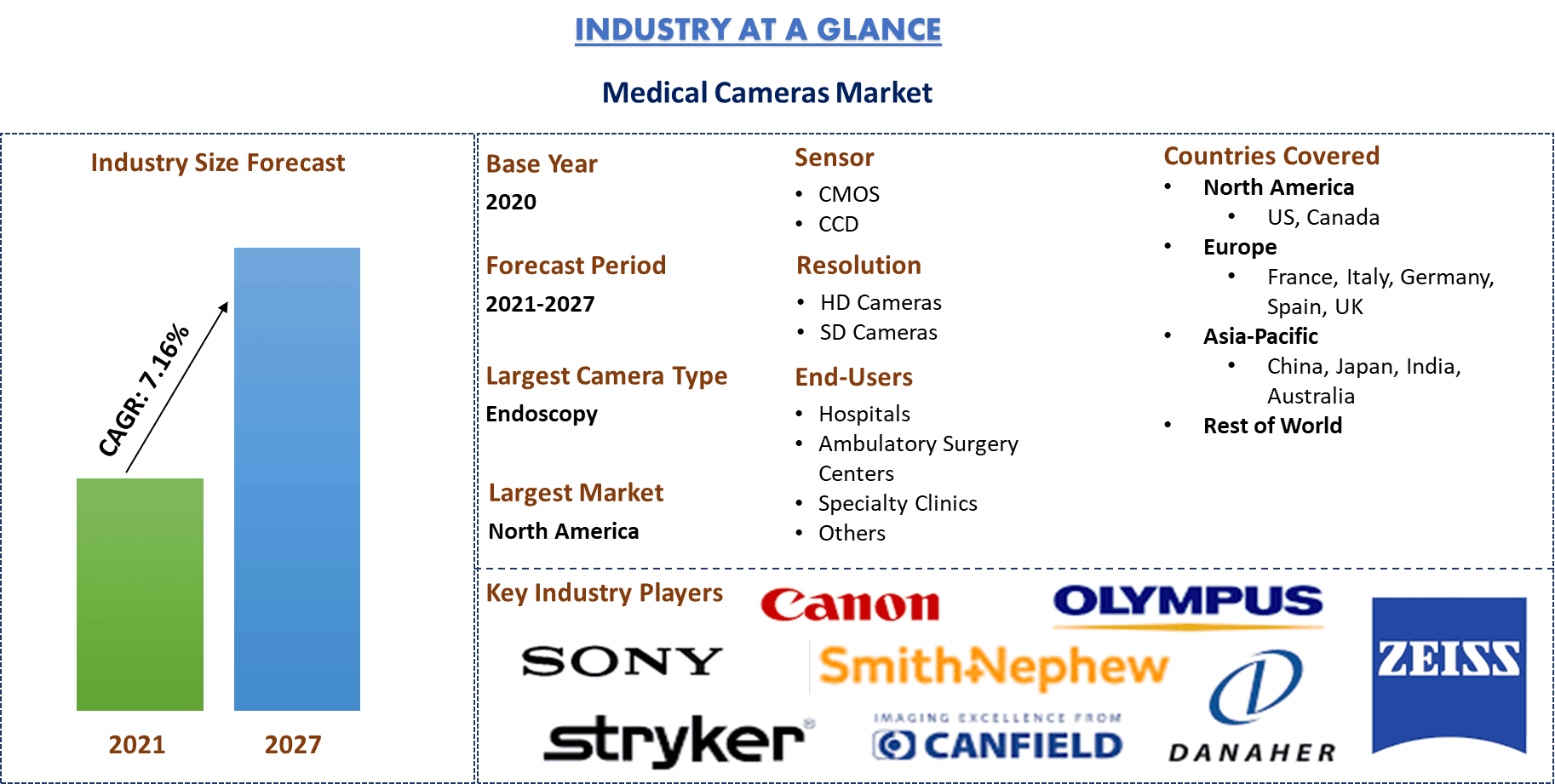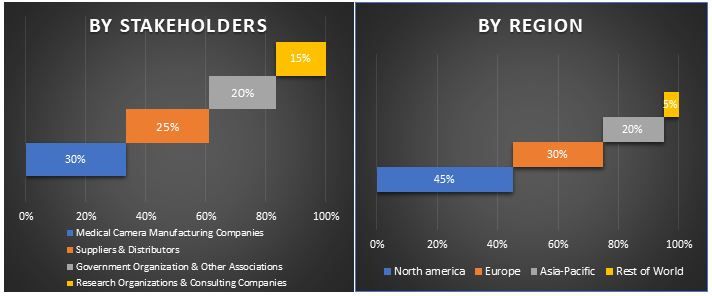- Home
- About Us
- Industry
- Services
- Reading
- Contact Us
Medical Cameras Market: Current Analysis and Forecast (2021-2027)
Emphasis on Camera Type (Endoscopy Cameras, Ophthalmology Cameras, Dermatology Cameras, Dental Cameras, Surgical Microscopy Cameras, Others); Sensors (CMOS, CCD); Resolution (HD cameras, SD cameras); End-User (Hospitals, Ambulatory Surgery Centers, Specialty Clinics, Others); and Region & Country.

Medical Cameras Market was valued at US$ 2.5 billion in 2020 and is anticipated to reach US$ 4 billion by 2027 displaying an elevated CAGR of 7.2% over the forecast period (2021-2027). A Medical camera allows surgeons and other medical practitioners to capture high-quality images during microscopy and other surgical procedures such as ophthalmology, endoscopy, arthroscopy, robotic surgery, among others. They help in the diagnosis and treatment of disease by revealing the actual condition of an internal organ.
The rising worldwide demand for medical cameras is because of the increasing technological advancements in surgical procedures and upsurge in MedTech venture capital investments. For instance, the medical technology venture capital investment all over the world was valued at US$ 5.7 billion in 2019 which rose to US$ 6.3 billion in 2020. In addition to this, the largest increase in the MedTech venture capital investment was seen during the years 2016 and 2017.
The growing prevalence of age-related diseases coupled with the rising geriatric population is another factor contributing to the growth of the global medical cameras market. For instance, according to the United Nations, In 2019, 13.2% of the worldwide population was aged 60 years or above. Further, it is anticipated that nearly 21.4% of the total worldwide population will be aged 60 years or over by 2050. Given these facts, there is an increase in the number of people who are not suitable for open surgeries. As a result, there is an increase in the adoption of minimally invasive surgical procedures augmenting the growth of the medical cameras market globally.
The increased demand for endoscopic procedures is due to the growing patient pools and mortality rates of gastrointestinal diseases all over the world. Furthermore, the increasing number of surgeries due to the growing prevalence of types of GI cancer has also propelled the worldwide demand for medical cameras procedures. For instance, according to the Globocan 2020, 10% of incidences were reported of colorectum cancer followed by 5.6% of new cases of stomach cancer were reported all over the world.
However, some of the restraints in the market include stringent government regulations and the high cost of medical cameras. Besides, lack of skilled medical professionals and product discontinuation are some other factors impeding the growth of this market all over the world.
Prevalence of Gastrointestinal Diseases in Selected Countries, 2019 and Percentage of Incidences & Mortality due to types of GI cancer, Worldwide, 2020
Olympus Corporation, Sony Corporation, Danaher, Canon Inc., Carl Zeiss AG, Canfield Scientific Inc., Richard Wolf GmbH, Stryker Corporation, Smith & Nephew, Medicam are some of the prominent players operating in the global medical cameras market. Several M&As along with partnerships have been undertaken by these players to facilitate customers with innovative products.
Insights Presented in the Report
“Amongst Camera Type, Endoscopy cameras hold the major share”
Based on camera type, the market is classified into endoscopy cameras, ophthalmology cameras, dermatology cameras, dental cameras, surgical microscopy cameras, and other cameras. The endoscopy cameras segment dominated the medical cameras market and grabbed XX% market share in 2020. This segment will witness a considerable CAGR of XX% during the forecast period (2021-2027F) owing to the increase in the number of endoscopic procedures and growing prevalence of diseases such as gastrointestinal diseases, cancer, arthritis, etc. For instance, according to an international survey conducted by a team of scientists of the University of Gothenburg, nearly 40% of adults suffer from a functional gastrointestinal disorder, among 73,000 persons belonging to 33 countries.
“Amongst Sensor, CMOS sensor segment is anticipated to grow at the highest CAGR during the analyzed period”
based on types of sensors, the global medical cameras market is divided into CMOS and CCD. The CMOS segment held the major market share valued at XX% in 2020 and will grow at a considerable CAGR of XX% during the analyzed period (2021-2027F). CMOS sensors is an electronic chip which is used to create images in digital cameras. The growth of this segment is attributed to the various advantages of CMOS sensors over CCD sensors such as less power consumption, low cost, and increased consolidation.
“Amongst Resolution, HD cameras hold the major share”
Based on Resolution, the market is fragmented into HD cameras and SD cameras. In 2020, the HD Cameras segment dominated the medical cameras market and accounted for XX% market share. This segment will witness a considerable CAGR of XX% during the forecast period (2021-2027F) owing to the need for high quality images in various medical facilities as HD cameras contains more pixel and allows the medical technologist to record larger, better-quality images for higher recognition. For instance, high-definition technology offers 1080p pixel density and 16:9 aspect ratio offering wide screen type view enabling medical practitioners to visualize and perform surgical procedures more precisely.
“Amongst End-Users, Hospitals segment is anticipated to grow at the highest CAGR during the analyzed period”
Based on End-Users, the market is segmented into hospitals, ambulatory surgery centers, specialty clinics and others. Among end-users, the hospitals segment acquired the major market share of XX% in 2020 and is expected to continue its dominance during the projected timeframe owing to the rapid developments in healthcare infrastructure and increase in the number of hospitals all over the world. For instance, according to the American Hospital Association, in 2019, the total number of all the hospitals in the United States was 6090. Amongst these, 5,141 were U.S. community hospitals and 208 were federal government hospitals.
“North America signifies one of the largest markets of medical cameras market”
For a better understanding of the market dynamics of the medical cameras market, a detailed analysis was conducted for different regions across the globe including North America (United States, Canada, and the Rest of North America), Europe (Germany, France, Italy, Spain, United Kingdom and Rest of Europe), Asia-Pacific (China, Japan, India, Australia and Rest of APAC), Rest of World has been conducted. North America dominated the market and generated revenue of USD XX billion in 2020 owing to the government support for advanced research and development for medical cameras and increasing awareness regarding the benefits offered by them. Furthermore, The surging demand for medical cameras is due to the growing geriatric population and rise in gastrointestinal disorders across the region. For instance, in 2019, the United States has 22% of the adult population suffering from gastrointestinal diseases while Japan has only 9% of the adult population suffering from GI disease. However, Asia-Pacific is also identified as emerging markets offering significant growth opportunities for key players owing to the rapidly developing healthcare infrastructure.
Reasons to buy this report:
- The study includes market sizing and forecasting analysis validated by authenticated key industry experts
- The report presents a quick review of overall industry performance at one glance
- The report covers an in-depth analysis of prominent industry peers with a primary focus on key business financials, product portfolio, expansion strategies, and recent developments
- Detailed examination of drivers, restraints, key trends, and opportunities prevailing in the industry
- The study comprehensively covers the market across different segments
- Deep dive regional level analysis of the industry
Customization Options:
Medical Cameras Market can further be customized as per the requirement or any other market segment. Besides this, UMI understands that you may have your own business needs, hence feel free to connect with us to get a report that completely suits your requirements.
Table of Content
Analyzing the historical market, estimation of the current market, and forecasting the future market of the global medical cameras were the three major steps undertaken to create and analyze the demand of medical cameras for different applications across major regions globally. Exhaustive secondary research was conducted to collect the historical market numbers and estimate the current market size. Secondly, to validate these insights, numerous findings and assumptions were taken into consideration. Moreover, exhaustive primary interviews were also conducted, with industry experts across the value chain of the medical cameras sector. Post assumption and validation of market numbers through primary interviews, we employed a top-down approach to forecast the complete market size. Thereafter, market breakdown and data triangulation methods were adopted to estimate and analyze the market size of segments and sub-segments the industry pertains to. Detailed methodology is explained below:
Analysis of Historical Market Size
Step 1: In-Depth Study of Secondary Sources:
Detailed secondary study was conducted to obtain the historical market size of the medical cameras market through company internal sources such as annual report & financial statements, performance presentations, press releases, etc., and external sources including journals, news & articles, government publications, competitor publications, sector reports, third-party database, and other credible publications.
Step 2: Market Segmentation:
After obtaining the historical market size of the medical cameras market, we conducted a detailed secondary analysis to gather historical market insights and share for different segments for major regions. Major segments included in the report are camera type, sensor, resolution and end-users. Further country-level analyses were conducted to evaluate the overall demand for medical cameras in every region.
Step 3: Factor Analysis:
After acquiring the historical market size of different segments and sub-segments, we conducted a detailed factor analysis to estimate the current market size of medical cameras. Further, we conducted factor analysis using dependent and independent variables such as increasing surgical procedures and the growing geriatric population. A thorough analysis was conducted for demand and supply-side scenarios considering top partnerships, merger and acquisition, business expansion, and product launches in the medical camera industry across the globe.
Current Market Size Estimate & Forecast
Current Market Sizing: Based on actionable insights from the above 3 steps, we arrived at the current market size, key players in the medical cameras market, and market shares of the segments. All the required percentage shares split, and market breakdowns were determined using the above-mentioned secondary approach and were verified through primary interviews.
Estimation & Forecasting: For market estimation and forecast, weights were assigned to different factors including drivers & trends, restraints, and opportunities available for the stakeholders. After analyzing these factors, relevant forecasting techniques i.e. top-down approach was applied to arrive at the market forecast about 2027 for different segments and subsegments across the major markets globally. The research methodology adopted to estimate the market size encompasses:
- The industry’s market size, in terms of value (USD) and the adoption rate of medical cameras across the major markets domestically
- All percentage shares, splits, and breakdowns of market segments and sub-segments
- Key players in the medical cameras market in terms of services offered. Also, the growth strategies adopted by these players to compete in the fast-growing market
Market Size and Share Validation
Primary Research: In-depth interviews were conducted with the Key Opinion Leaders (KOLs) including Top Level Executives (CXO/VPs, Sales Head, Marketing Head, Operational Head, and Regional Head, Country Head, etc.) across major regions. Primary research findings were then summarized, and statistical analysis was performed to prove the stated hypothesis. Inputs from primary research were consolidated with secondary findings, hence turning information into actionable insights.
Split of Primary Participants in Different Regions
Market Engineering
Data triangulation technique was employed to complete the overall market estimation and to arrive at precise statistical numbers of each segment and sub-segment of the medical cameras market. Data was split into several segments & sub-segments post studying various parameters and trends in the areas of the camera type, sensors, resolution and end-users of the medical cameras market.
Main Objective of the Medical Cameras Market Study
The current & future market trends of medical cameras were pinpointed in the study. Investors can gain strategic insights to base their discretion for investments from the qualitative and quantitative analysis performed in the study. Current and future market trends were determined the overall attractiveness of the market at a regional level, providing a platform for the industrial participant to exploit the untapped market to benefit as a first-mover advantage. Other quantitative goals of the studies include:
- Analyze the current and forecast market size of medical cameras in terms of value (USD). Also, analyze the current and forecast market size of different segments and sub-segments
- Segments in the study include areas of the camera type, sensors, resolution and end-users
- Define and analysis of the regulatory framework for the medical camera industry
- Analyze the value chain involved with the presence of various intermediaries, along with analyzing customer and competitor behaviors of the industry
- Analyze the current and forecast market size of the medical cameras market for the major region
- Major regions studied in the report include North America (the United States and Canada), Europe (Germany, France, Italy, Spain, and United Kingdom), Asia-Pacific (China, Japan, Australia and India), and the Rest of the World
- Company profiles of the medical cameras market and the growth strategies adopted by the market players to sustain in the fast-growing market
- Deep dive regional level analysis of the industry
Related Reports
Customers who bought this item also bought












